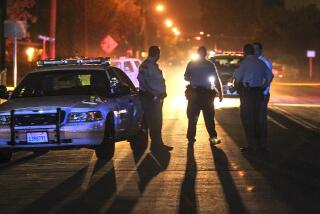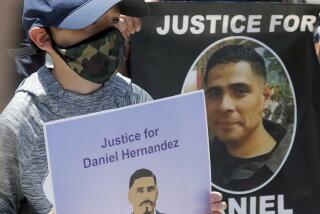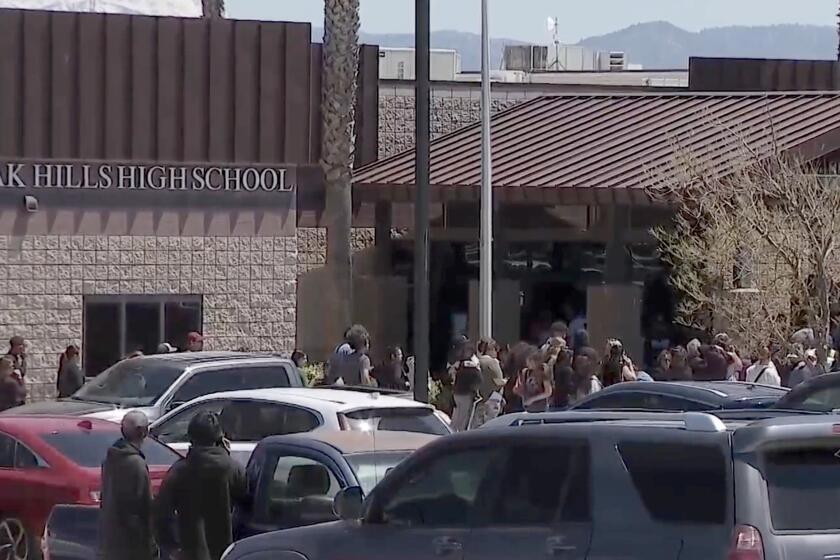Grieving mom takes on the federal government
Carol Champommier vs. the United States of America.
That’s not a phrase that Carol Champommier ever expected to see. She’s a schoolteacher, not an activist; a rule follower, not a renegade.
But Champommier is suing the United States because a federal agent shot her son to death in a parking lot encounter that played out like a scene from an action movie, where two unrelated story lines coalesce in violent tragedy.
Government lawyers contend the shooting three years ago was reasonable — that 18-year-old Zac Champommier tried to run down an officer with his car, creating a “deadly, immediate threat” that justified gunfire.
Carol Champommier blames poor training, reckless conduct and a coverup by officers unwilling to acknowledge they killed a panicky kid, not a criminal.
Zac had driven to the parking lot in Studio City to meet a young man he’d chatted with online. But when Zac arrived, he saw the acquaintance scuffling with what seemed to be a bunch of middle-aged toughs. Apparently, the acquaintance had been looking for Zac, and the men had seen him peering into parked cars and thought he might be a thief.
The men were part of an undercover law enforcement task force: sheriff’s deputies, LAPD officers and DEA agents, in leather jackets and T-shirts. They’d just completed a narcotics raid and were “debriefing” in the public lot, with the drugs and cash they’d confiscated still in their unmarked cars.
It’s too late now to ask what Zac thought as he stepped on the gas of his mother’s Toyota and the car struck a deputy holding a gun. A DEA agent nearby responded by firing off three shots.
Was Zac trying to mow down officers to keep them from arresting his acquaintance? Or was he just trying to maneuver a balky stick shift to flee men dressed like hoodlums and armed with guns?
::
Testimony in Champommier’s lawsuit ended this week in the courtroom of U.S. District Judge Michael Fitzgerald. Her friends and neighbors from Porter Ranch showed up. So did Zac’s friends, who were on spring break. Champommier counseled them on her Facebook page: “Attire is business casual, no flip-flops.”
Attorneys will make closing statements later this month. Then the judge — who heard the case without a jury — will determine if the use of deadly force by officers was “objectively reasonable” under the circumstances that night.
It’s a question of both perception and facts, and the trial offered plenty of both.
A customer at the Chipotle restaurant nearby described two men with guns in the parking lot. One “looked like a biker person” in a leather jacket. The other held his weapon “like in the movies, very professionally” before firing “boom, boom, boom” at Zac’s car.
“I thought they were all biker gangs,” the witness testified. He was so unnerved by the violence, he rushed his children into his car and drove off with their seat belts unfastened.
Crash and ballistics experts spent days on the stand parsing details: the trajectory of the bullets, the speed of Zac’s car and how many seconds it takes to unholster a weapon, draw, aim and fire.
Champommier sat in the front row each day, staring at photos of her car with bloodstains and a bullet hole in the driver’s spot, listening to witnesses and lawyers spar over the final moments of her son’s life, watching DEA agent Peter LoPresti demonstrate how he pointed his gun at the car’s driver and fired the fatal shots.
I wondered as I watched LoPresti on the stand, earnest and unemotional, how many times he must have privately replayed that evening in his mind, trying to recall exactly what he felt, thought and did in the moments that changed so many lives.
LoPresti fired, he testified, because Zac’s car rammed the deputy hard enough to thrust the lawman onto its hood. Things happened so fast he didn’t have time to think. “It was simply a reaction” to his perception that officers’ lives were in danger, he said.
We “had to have that threat stopped. That’s why I shot.”
::
It’s not hard to imagine that in the context of that night, the unexpected might have felt like a threat.
That the officers, amped up on adrenaline, might have been primed to respond with firepower to trouble in the parking lot. That the public might have presumed that the dressed-down cops were actually gun-toting criminals.
Reasonableness can be a squishy concept; your view depends on your prism.
The government seems determined to blame Zac for his own demise, questioning, in finger-wagging style, even the young man’s choice to meet up with a stranger he’d connected with online. The judge, to his credit, shut that avenue down.
The issue is not what brought Zac to that parking lot but what circumstances led to the fatal shots.
“These agents and officers have a tough job,” acknowledged Champommier’s lawyer, Cara Eisenberg. But they created an unnecessary danger by debriefing in a crowded public parking lot.
“Our position is that they shouldn’t set up a situation where they can’t take the time to discern the difference between a minor traffic accident ... and a threat of deadly force,” she said. “Nobody hates the cops. We just want them to be as fair as possible, and not do harm to the rest of us.”
It’s not uncommon, DEA agents testified, for undercover officers to assemble in a public spot and leave their cache of seized guns, narcotics and cash unguarded in their unmarked cars.
It’s also courting trouble. Isn’t it reasonable to expect that officers would log that evidence at the station and lock it down before heading off to discuss the case?
The nature of much of law enforcement is making split-second choices in life-or-death situations. That’s why it troubles me that the government seems so cavalier about how that evening turned out.
Maybe those officers need to believe they were not responsible for what happened in that parking lot. It must be tough to contemplate the possibility that a frightened young man who meant no harm was gunned down for no good reason that night.
More to Read
Start your day right
Sign up for Essential California for news, features and recommendations from the L.A. Times and beyond in your inbox six days a week.
You may occasionally receive promotional content from the Los Angeles Times.






